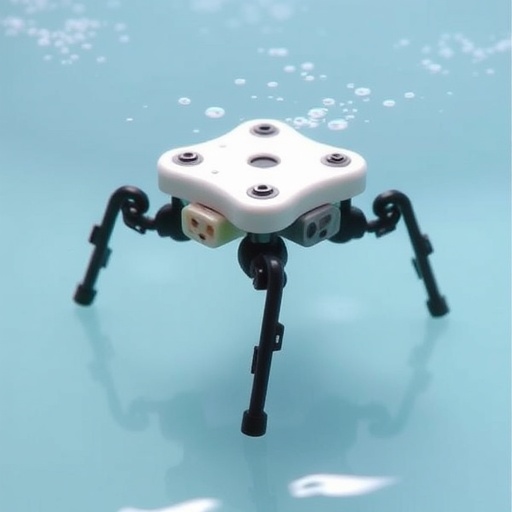In the dynamic field of robotics, researchers are relentlessly pushing the boundaries of innovation and technology. A recent breakthrough made by a team of engineers at the University of Virginia promises to revolutionize the design and functionality of small, autonomous robots. Imagine tiny machines that glide seamlessly over water, resembling the elegant movements of water striders, capable of monitoring environmental pollutants or conducting research in areas too dangerous for human reach. The foundation of this emerging technology is a revolutionary fabrication method named HydroSpread, which allows soft, floating robots to be produced directly on the surface of water.
The HydroSpread method represents a significant leap forward in the evolving realm of soft robotics. Traditionally, the materials utilized for soft robotic devices were fabricated on rigid surfaces such as glass or plastic. This method often led to damage during the transfer process when attempting to move the delicate films to water for operational testing. However, HydroSpread changes the game by leveraging the water itself as the working surface for construction. This novel approach facilitates the formation of ultrathin, uniform sheets of liquid polymer that spread naturally on the water’s surface, creating an ideal substrate for advanced design.
Professor Baoxing Xu’s team embarked on this pioneering research, overcoming numerous technical challenges associated with traditional soft robotic fabrication. With the innovative HydroSpread technique, they have demonstrated the ability to create intricate patterns within these films using finely tuned laser technology. The precision achieved by this method is unprecedented, allowing the researchers to carve complex shapes—ranging from simple circles to intricate logos—directly onto the polymer sheets. This level of detail is crucial for developing functional soft robotic prototypes that can perform specific tasks effectively.
Building on the foundation laid by HydroSpread, the researchers created two bio-inspired prototypes: HydroFlexor and HydroBuckler. HydroFlexor mimics the paddling motion of aquatic creatures, enabling it to glide smoothly across the water’s surface. In contrast, HydroBuckler emulates the unique locomotion of water striders, which use a technique known as buckling to propel themselves forward. These prototypes highlight the practical applications of Xu’s innovative fabrication approach, demonstrating how nature-inspired designs can lead to functional robotic solutions.
In laboratory testing, both devices were powered by an overhead infrared heater. As the temperature of the films increased, their layered structure responded dynamically, bending and buckling to create the desired locomotion. This reaction allowed the devices to adjust their speed and direction by cycling the heat on and off. These findings not only provide proof of concept for the HydroSpread fabrication method but also open avenues for designing robots that can autonomously react to their environment—a significant step toward future applications in fields like environmental monitoring and disaster response.
Professor Xu emphasizes the importance of this research, noting that HydroSpread grants an unparalleled level of precision and simplification to the fabrication process. By eliminating the need for rigid substrates and enhancing structural stability on a liquid platform, the risk of failure during manufacturing is minimized. This advancement could lead to breakthroughs far beyond small robotic designs; it paves the way for the development of various applications, including wearable medical sensors and flexible electronics that require durability without compromising on the lightweight properties essential for effectiveness.
The implications of HydroSpread extend into realms that merge science and technology with health care, environmental science, and consumer electronics. As the need for adaptable and responsive devices grows, HydroSpread stands as a potential game changer in the manufacturing landscape. Smaller, lighter devices that can operate on challenging surfaces could usher in a new era of robotic applications, significantly improving our ability to interact with and understand our environment in real-time.
Research funding provided by the National Science Foundation and support from 4-VA has propelled this groundbreaking work forward, allowing undergraduate and graduate researchers in Xu’s lab to engage in hands-on experiments, fostering a new generation of engineers capable of leveraging such advanced techniques. The incorporation of students into this research process not only amplifies the team’s capabilities but also ensures that the next generation of engineers is well-prepared to tackle future challenges in robotics and materials science.
The potential for creating robotic systems that are responsive to external stimuli, whether it be light, heat, or magnetic fields, opens a multitude of possibilities. The adaptability inherent in Xu’s designs could one day lead to robots that autonomously navigate through turbulent environments, making independent decisions based on their sensory inputs. This level of sophistication is currently a focus within the field of soft robotics and represents a significant frontier for developers and researchers alike.
In conclusion, the HydroSpread fabrication method stands poised to redefine soft robotics by enabling the seamless creation of on-water walkable devices. Its potential applications extend far beyond mere robotics, ensuring that this research may impact various industries ranging from health care to environmental science and manufacturing. The ingenuity demonstrated by Professor Baoxing Xu and his team exemplifies the intersection of nature and technology, where the lessons learned from the natural world can spark innovation and create groundbreaking tools for the benefit of society.
By harnessing the unique capabilities of HydroSpread, researchers are not just fabricating soft robots; they are laying the groundwork for an advanced technological landscape where small, agile devices could play a crucial role in monitoring, health care, and beyond. As this field continues to evolve, the possibilities for future applications seem nearly limitless, charting a course toward innovations that enhance our understanding and interaction with the world around us.
Subject of Research: HydroSpread Method for Soft Robotics
Article Title: Processing Soft Thin Films on Liquid Surface for Seamless Creation of On-Liquid Walkable Devices
News Publication Date: 24-Sep-2025
Web References: Science Advances
References: 4-VA
Image Credits: Baoxing Xu, UVA School of Engineering and Applied Science
Keywords
Soft Robotics, HydroSpread, Autonomous Robots, Bio-Inspired Engineering, Liquid Fabrication, Environmental Monitoring, Polymer Manufacturing, Innovation, Precision Engineering, Future Technology, Mechanical Engineering.




